Use the Sketch Solving Status
This is a quick way to analyze the sketch and detect whether a sketch is under or over constrained.
Select all the circles.
Click Constraints Defined in Dialog Box
 in the Constraints toolbar.
in the Constraints toolbar.
The Constraint Definition dialog box appears. Select the Fix option.
The geometry color has turned to green indicating that the view geometries
are iso-constrained.
Click OK in the dialog box. Select the two vertical parallel lines.
Click Constraints Defined in Dialog Box
 and select the Fix and Vertical option.
and select the Fix and Vertical option.
The geometry color has turned to green indicating that the view geometries
are iso-constrained.
Click OK in the dialog box.
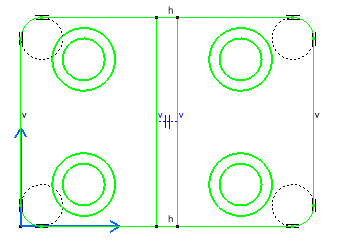
Click Sketch Solving Status
 from the Tools
toolbar.
from the Tools
toolbar.
This command gives you a quick diagnosis
of the geometry status.
The Sketch Solving Status dialog box appears and informs
you of the general geometry status, whether it is under-constrained,
over-constrained or iso-constrained.

Meanwhile, the information given in
the Sketch Solving Status dialog box is highlighted in red
in the geometry area and the element that are under-constrained are
highlighted.
In this case the four points are highlighted indicating that they are
under-constrained.
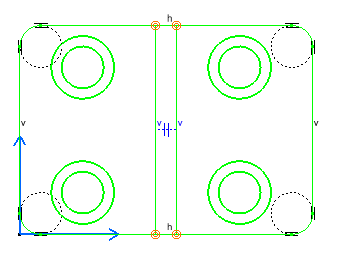

Use the Sketch Analysis
This method gives a detailed analysis of the sketch. It provides the status of each element and a constraint of a sketch. It allows you to hide constraints, create geometry, visualize use-edges in the sketch. You deactivate, isolate, delete and also replace a 3D geometry.
The Sketch Solving Status dialog box is still
displayed. Click Sketch Analysis
 in the Sketch Solving Status dialog box or select Tools
> Sketch Analysis from menu.
in the Sketch Solving Status dialog box or select Tools
> Sketch Analysis from menu.
The Sketch Analysis dialog box appears. It contains
three tabs: Geometry, Use-edges
and Diagnostic.
Construction elements appear with a blue color in the geometry.
Note that you have the possibility to sort the elements
displayed in the dialog box by Name, status or Type, by clicking the
appropriate tab. Note that you can select elements from the dialog box
and they will be highlighted in the geometry area.
The Geometry tab displays information about
all the connex profiles in the view.
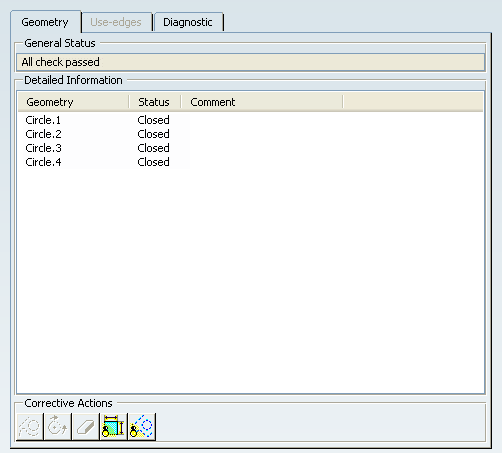
-
General Status: global status
on all the view geometries.
-
Detailed Information:
provides a detailed status/comment on each profile of the
view.
-
Corrective Actions
: according to the analyzed element you select and which
is not correct, you will be able to:
-
 turn this element into a construction element
turn this element into a construction element
-
 close a profile that is not
close a profile that is not
-
 erase a disturbing element
erase a disturbing element
-
 hide all constraints in the view
hide all constraints in the view
-
 hide all construction geometries in the view and in
the detailed information area of the Geometry
tab
hide all construction geometries in the view and in
the detailed information area of the Geometry
tab
Click the Diagnostic tab. It gives information
about every element of the geometry or constraint of a view.
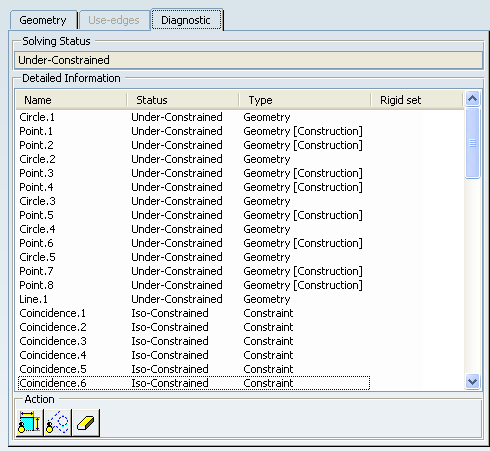
The information on this tab displays
a full diagnosis of the view geometry. It provides a global analysis
of the view as a whole, and specifies whether individual geometrical
elements in the view are under-constrained (under-defined), over-constrained
(over-defined) or iso-constrained (well defined):
- Solving Status: provides a quick overall
analysis of the view geometry
- Detailed Information: provides
a detailed status on each constraint and geometrical element
of the view, and lets you know what type of element it is
(geometry, constraint)
- Action: according to the analyzed element
you select, you will be able to:
 hide all constraints in the view and in the detailed
information area
hide all constraints in the view and in the detailed
information area hide all construction geometries in the view and in
the detailed information area of the Diagnostic
tab
hide all construction geometries in the view and in
the detailed information area of the Diagnostic
tab  erase geometry
erase geometry
Select Hide Construction Geometries
 from the Sketch Analysis dialog box.
All the construction elements are hidden both from the dialog
box.
from the Sketch Analysis dialog box.
All the construction elements are hidden both from the dialog
box.
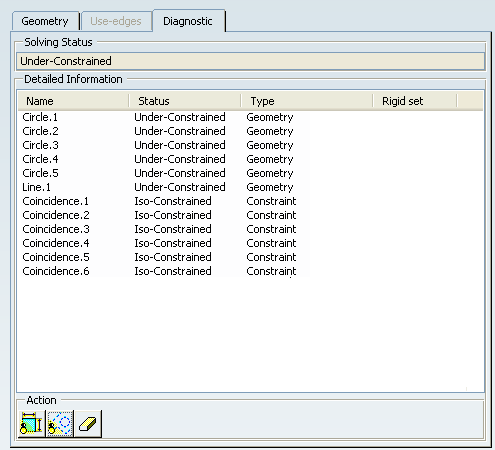
If you select items from the Detailed
Information table, they will be highlighted in the view,
which enables you to identify them easily. To solve constraint-based
problems in the view, you need to edit the geometry directly.
- Drafting documents do not contain any associative use-edges,
so the Use-edges tab is disabled
in the Sketch Analysis dialog box.
- Driving dimensions use invisible constraints to drive
geometries. So these constraints appear in the Diagnostic
tab, but are not highlighted in geometry of the view because
they are invisible. If such dimensional constraints (invisible
constraint created for driving dimension) are deleted in
the Diagnostic tab, then the dimension will turn
not up-to-date. The dimension must be manually deleted.
|